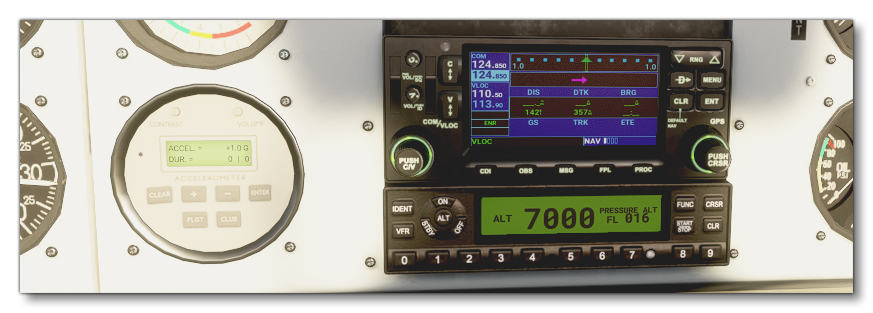INSTRUMENTS
When creating your aircraft, possibly the most important thing for the end user is the instrumentation. It's through the various gauges and visual displays that the user gets their information about the aircraft, its place in the world, and how it is flying. As such, it is vitally important that these are set up correctly and function as they would in the "real world".
In Microsoft Flight Simulator, the aircraft instrumentation is split into three main categories, each of which is outlined below, and each of which has a growing complexity for setting up and getting working.
The External Cockpit
The external cockpit is the display that the user will see when they are flying or viewing the aircraft in 3rd person mode:

The various instruments on show in the external cockpit are defined using the cockpit.cfg file, and in this tutorial we won't be going into how these are created as the following page of the main documentation outlines the details and it's all fairly self explanatory:
Steam Gauges
Within the virtual cockpit, an aircraft will often have "steam" gauges:

These gauges need to be created as part of the aircraft Cockpit model, and will then be referenced and controlled using the various Model Behaviors templates. The actual creation of these kinds of gauge models is covered on the following page:
And you can find information on how to communicate and control these kinds of gauages on the following page:
Glass Cockpit Gauges
Within the virtual cockpit, an aircraft will also frequently have digital gauges, or what is known as "glass cockpit" displays:

We'll be looking at how to create these in more detail in this tutorial, as they are by far the most complex of the instrumentation types to make. These kinds of gauges come in two "flavours":
- WASM: WASM gauges are written using C++ code in an external editor (like Visual Studio). The main documentation for these kinds of gauges is extensive and can be found here: There are also a number of aircraft samples that make use of WASM modules and show how they can be set up and used, which you can find here: We also have a brief tutorial for setting up and creating WASM Gauges here:
- JavaScript/HTML/CSS: This method for creating gauges requires an HTML page to provide the gauge framework, a JavaScript file to provide the gauge logic, and a CSS file to style the gauge (and an optional
panel.xmlfile for additional functionality and/or modifications). The main documentation for these kinds of gauges can be found here: You can find the pages of our HTML/JS/CSS tutorials below.
Which of these you use is entirely up to you and neither is better than the other, since they each have their own pros and cons.